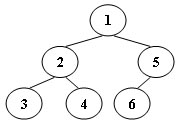标签:堆栈 输入 com out uniq sep 使用 gen lines
An inorder binary tree traversal can be implemented in a non-recursive way with a stack. For example, suppose that when a 6-node binary tree (with the keys numbered from 1 to 6) is traversed, the stack operations are: push(1); push(2); push(3); pop(); pop(); push(4); pop(); pop(); push(5); push(6); pop(); pop(). Then a unique binary tree (shown in Figure 1) can be generated from this sequence of operations. Your task is to give the postorder traversal sequence of this tree.

Each input file contains one test case. For each case, the first line contains a positive integer N (≤) which is the total number of nodes in a tree (and hence the nodes are numbered from 1 to N). Then 2 lines follow, each describes a stack operation in the format: "Push X" where X is the index of the node being pushed onto the stack; or "Pop" meaning to pop one node from the stack.
For each test case, print the postorder traversal sequence of the corresponding tree in one line. A solution is guaranteed to exist. All the numbers must be separated by exactly one space, and there must be no extra space at the end of the line.
6 Push 1 Push 2 Push 3 Pop Pop Push 4 Pop Pop Push 5 Push 6 Pop Pop
3 4 2 6 5 1
可以使用堆栈以非递归方式实现顺序二进制树遍历。你的任务是给出这棵树的后序遍历序列。
每个输入文件包含一个测试用例。对于每种情况,第一行包含正整数N(≤ 3 0),它是节点的总数量在树(并且因此节点编号从1到N)。然后接下来是N行,每行描述一种堆栈操作,格式为:“Push X”,其中X是被推入堆栈的节点的索引; 或“Pop”表示从堆栈中弹出一个节点。
对于每个测试用例,在一行中打印相应树的后序遍历序列。保证存在解决方案。所有数字必须用一个空格分隔,并且在行的末尾不能有额外的空格。
今天先看看题,明天再写。。
标签:堆栈 输入 com out uniq sep 使用 gen lines
原文地址:https://www.cnblogs.com/jiamian/p/10714354.html